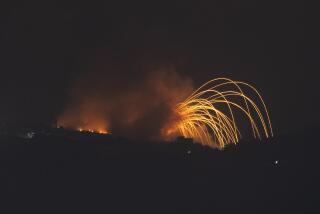The Deadly Consequences of Shaking the Baby
Many arrive at the emergency room bearing no visible bruises, but clearly fighting for their lives.
They may be having seizures.
Or respiratory problems.
Some are comatose.
Through hysterical sobs, their parents often tell tales of falls from the diaper-changing table, or a sudden breathing problem after the baby had been sleeping peacefully.
Child advocacy experts like Dr. Karen Kay Imagawa of Childrens Hospital Los Angeles listen to it all with concern--and hopefully just the right amount of suspicion. Then they go to work. After stabilizing the child, doctors do a careful physical exam. The next steps are often a CT scan of the head and an eye exam with an ophthalmoscope.
“And sometimes,” says Imagawa with a sigh, “the stories don’t fit.”
Especially when the scan detects intracranial bleeding and the eye exam shows retinal hemorrhages.
Both findings point to a diagnosis of shaken baby syndrome--shaking so violent it can damage the brain or be fatal--or shaken impact syndrome, the same violent shaking coupled with slamming the child against a hard object.
It was shaken impact syndrome that prosecutors contend killed 8-month-old Matthew Eappen when he was in the care of British au pair Louise Woodward, now free after serving 279 days. Her conviction was reduced from second-degree murder to manslaughter.
Buried in the debate over whether Woodward should have gone free, say child abuse experts, is the severity of these syndromes--and how dangerous shaking an infant can be.
Whenever a case of shaken baby syndrome comes to light, other parents often become alarmed at the common parental practices of lifting a baby high into the air or playing “horsy,” wondering if these activities, too, put their baby at risk, says Dr. Randell Alexander, vice chairman of the U.S. Advisory Board on Child Abuse and Neglect and associate professor of pediatrics at the University of Iowa.
The difference, Alexander says, is like night and day. He compares the effects of shaken baby syndrome or shaken impact syndrome to what it would take to “shake the stuffing out of a teddy bear’s head.”
Put another way: “It’s worse than falling out of a second-, third- or fourth-story window,” he says.
*
What actually happens during the act of shaken baby syndrome?
Experts such as Alexander, after hearing confessions, have pieced together this common scenario: A parent picks up the child, who is usually under 1 year of age, under the arms and holds him upright, staring into the child’s face and shaking him violently, usually to get him to stop crying.
“We’re talking about a lot of violence,” Alexander says. “The whole event probably lasts five to 10 seconds.” But within 10 seconds, he says, there might be 30 shakes.
One mother, convicted in a shaken baby syndrome case, told Alexander: “To an observer, it would have looked like I was shaking the head so hard the head would have fallen off.”
“The brain is not built for that repeated acceleration / deceleration,” Alexander says.
“The repetitive nature does add to the brain insult,” says Dr. Jan Bays, chairwoman of the American Academy of Pediatrics’ Committee on Child Abuse and Neglect and Portland, Ore., pediatrician who specializes in child abuse diagnosis and treatment.
What goes on inside the brain?
“There is direct injury to brain tissue, there is shearing injury to neurons and there is tearing of veins between the brain and the skull,” Bays says. “Brain cells are injured. They leak fluid. Swelling occurs, which cuts off circulation to the brain.”
After the shaking, the frustrated parent or other guardian will often throw the child on a bed, or the floor or other hard surface, worsening the injury. “More than half of shaken babies have an associated impact injury,” Imagawa says.
First written about in the medical literature in the 1960s and ‘70s, shaken baby syndrome probably occurs with 1,200 to 1,500 infants a year in the United States, Alexander estimates, basing the numbers on figures drawn from several centers in the absence of precise national statistics. About 300 shaken infants die every year.
(In L.A. County, 17 children died at the hands of their parents or others from shaken baby syndrome, blunt force cerebral trauma, or a combination of the two, in 1995, the latest year for which figures are available, says Dr. Michael Durfee, coordinator of the child abuse prevention program for the county Department of Health Services.)
Alexander contrasts the national death rate for shaken babies--about 25%--to a much lower death rate of less than 1% found in a study of children’s falls, published in 1991 in the Journal of Trauma. Only one of 118 children who fell from heights of 10 to 45 feet in that study died.
Of shaken baby syndrome, he says: “Very few people will be this vicious with a child.”
Those who survive shaken baby syndrome often have intellectual, motor and visual problems ranging from mild to incapacitating.
The person most likely to engage in violently shaking an infant, Bays says, is “someone with a low frustration tolerance, who acts out physically.” Alcohol, drugs and sleep deprivation can increase the risk of violence.
Another factor is a person’s distress level at the sound of a baby’s cry. One man, she recalls, said that the baby’s crying “felt like a dental drill piercing my brain.”
But, Bays adds, “Any of us are capable of losing control in a moment of frustration.” A colleague got a confession from a man who said, “I saw those ads [warning about shaking a baby] on TV and thought, ‘I’d never do that.’ ”
More to Read
Sign up for Essential California
The most important California stories and recommendations in your inbox every morning.
You may occasionally receive promotional content from the Los Angeles Times.









